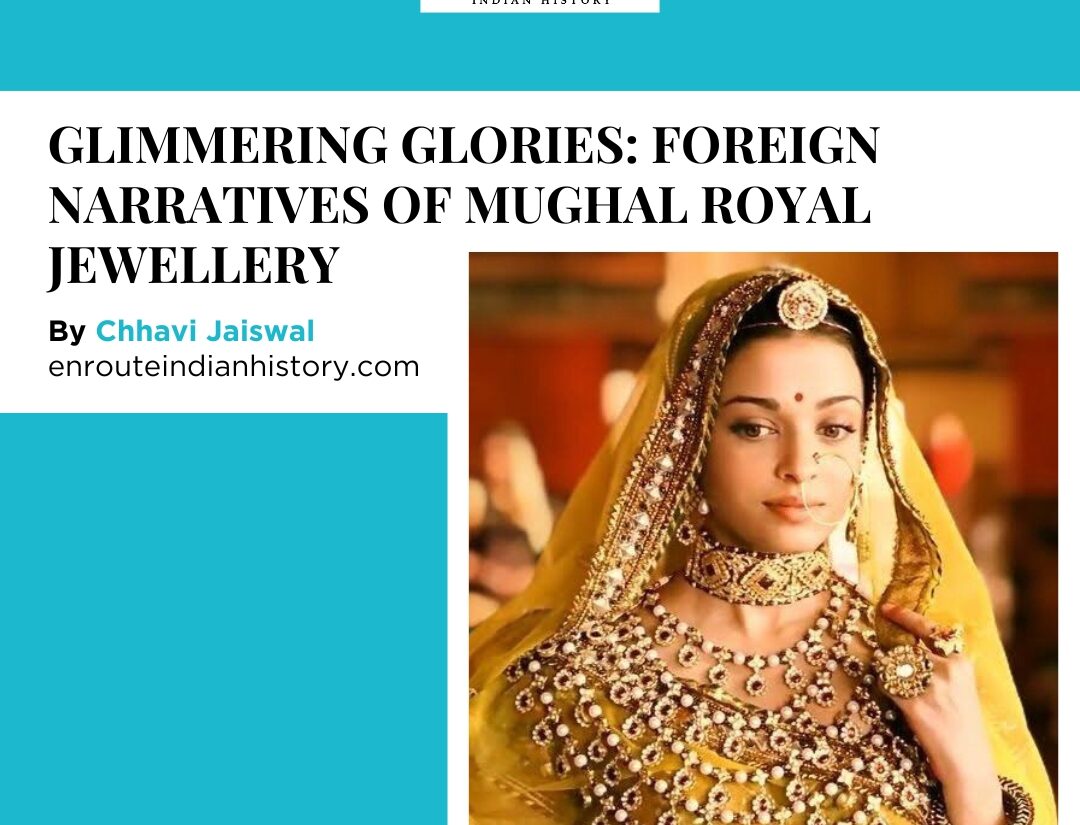Glimmering Glories: Foreign Narratives of Mughal Royal Jewellery
- EIH User
- August 1, 2024

Jewellery
Jewellery in the Indian subcontinent holds considerable significance within its material culture, embodying profound emotional and symbolic value that has evolved over centuries. Historically, the use of jewellery transcended gender boundaries, with men prominently displaying their collections and embellishing their weapons with precious jewels, thereby integrating them into the royal regalia. From antiquity, gold has been a symbol of prosperity, as reflected in the Rig Veda, which asserts that the giver of gold is rewarded with a life of light and glory. This association of gold with prosperity is further reinforced by its connection to the goddess Lakshmi. The Mughals, renowned for their extravagance, perpetuated this tradition, further embedding the cultural and economic importance of jewellery within the societal fabric. The Mughal courtly culture was famed for its extravagant display of jewels and precious metals. From delicate zari-embroidered clothes to some of the most precious gemstones, the Mughal court had it all. Travellers from far and wide were left awestruck by the Mughal display of jewellery. Many described the Mughal court in their royal accounts in detail and talked about the magnificent jewellery adorned by the royals. But before delving into the foreign perspectives regarding Mughal royal jewellery let us take a look at what was the extent of the Mughal treasury.

( A Mughal dagger with Sheath; Source: Metropolitan Museum of Art)
The Mughals had a separate department for managing precious stones and jewellery, known as the Jawahar-khana. This comprised a trustworthy treasurer, an experienced clerk and several skilled jewellers or johris. One can fathom the expanse of the jewels by the fact that they were classified into twelve classes. Rubies were the costliest stones and were used more than diamonds. Rubies, diamonds and emeralds valued at fifty thousand to one lakh were commonly stored in the jawahar-khana. Other precious and semi-precious stones in the collection included sapphires and pearls among others.
Mughal royal jewellery collection boasted of large uncut gemstones. The reason for this was not only a display of wealth but also to be kept as a reserve that could be sold off in times of need. Historically, the most famous jewels in this collection were the Koh-i-noor (the mountain of light) and the Darya-i-noor (the sea of light), both of which had been fought over many times. It is also noteworthy that gold was not as favoured among jewellery as much as gemstones. The golden ornaments were either enamelled or inlaid with precious stones, but jewellery of precious stones in the form of strings, necklaces, garlands and kadas were used on a large scale. The Mughal emperors were very particular about how they appeared to the public. Apart from jewellery, they even adorned their shoes and clothes with zari embroidery and gemstones.

(Darya-i-noor; Source: Wikimedia Commons)
One of the first mentions of mughal royal jewellery in foreign accounts comes from Father Antonio Monserrate who was a Spanish missionary to the court of Akbar. He keenly observed and wrote about the Mughal courtly culture, the emperor, and the people. In his account, he praised the silk cloth worn by the emperor embroidered in gold. He mentioned that “His Majesty’s cloak comes down to his hose, and boots cover his ankles completely and (he) wears pearls and gold jewellery.”( Chopra 1976)
British travellers provide us with a different foreign perspective on Mughal wealth. William Hawkins, a diplomat sent by the East India Company stayed in the court of Jahangir as an emissary for two years. He gives a detailed account of the collection of jewels possessed by the Mughals, noting that the King possessed 1.5 mans (=7.8 kgs) of diamonds that were rough and cut, large and small but not less than 2.5 carats; 12 mans ( = 302.4 kgs) of pearls; 2 mans (50.4 kgs) of rubies; 5 mans (126 kgs) of emeralds and numerous other precious stones. He also talks about semi-precious stones, including amethyst, ajuba, agate, quartz, cornelian, and opal, among others. These were not used for making jewellery but rather used in utensils like cups, wine vases, bowls, trays, etc., to be used in the Mughal household. Hawkins also noted that Jahangir had a collection of 200 glasses, 100 wine vases and 500 drinking cups made of spinels, emeralds, jade, turquoise and other stones. In his accounts, to convey the vast scale of the Mughal treasures, Hawkins used the Turkish unit battman which was used for grains and other bulky goods, equivalent to about 55 English pounds. The full extent of the empire’s wealth might be difficult to grasp today, as much of it was dispersed or seized by other empires in the subsequent centuries.
Hawkins was followed by Thomas Roe, another emissary of the East India Company who had visited India in 1615 intending to secure trading rights with India. He also noted the grandeur of the Mughal court, and gave a detailed description of Jahangir’s attire on his birthday noting “His turban was plumed with heron’s feathers; on one side was a ruby as big as a walnut; on the other side was a large diamond; in the centre was a large emerald, shaped like a heart. His sash was wreathed with a chain of pearls, rubies, and diamonds. His neck-chain consisted of three double strings of pearls. He wore armlets set with diamonds on his elbows; he had three rows of diamonds on his wrists; he had rings on nearly every finger.”( M. L. F. 1927) This description is enough to give us an idea of how lavishly the emperor would dress up on special occasions, not only to signify his prestige but also to project his power through wealth.

(Close up of a portrait of Jahangir by Abu-al Hasan; Source: Wikimedia Commons)
Niccolò Manucci, a Venetian traveller who visited the Mughal court during Aurangzeb’s reign, provides a vivid account of the courtly adornments worn by the ladies. He describes the bazuband, a type of arm ornament, as a lavish piece that extended two inches above the elbow, adorned with stones and pearls hanging from it. Manucci notes that the ladies had a particular fondness for rings, including a distinctive ring worn on their thumbs. Instead of a gemstone, this ring featured a small round mirror with a pearl set in it (arsi), reflecting the Mughal ladies’ frequent desire to admire their reflections. Additionally, he remarks that the princesses possessed six to eight sets of jewels, in addition to other elaborate pieces.

(A still from the film Jodhaa Akbar with the character of Jodha Bai portrayed by Aishwarya Rai wearing an arsi ring on her left hand)
Other foreign perspectives on Mughal opulence are vividly illustrated through the accounts of two notable French travellers, Jean-Baptiste Tavernier and François Bernier, who visited the Mughal courts of Shah Jahan and Aurangzeb. Tavernier, a renowned 17th-century French merchant and explorer, undertook six voyages throughout his life, visiting the Mughal court twice—first in Agra during Shah Jahan’s reign and later in Delhi under Aurangzeb. His descriptions of the Agra Fort highlight its lavishness, with vestibules adorned in gold and encrusted with pearls and rubies. During his visit to Aurangzeb’s court in the 1660s, Tavernier provided a detailed account of the Mughal royal jewellery. In a chapter dedicated to these treasures, he recounts how Aurangzeb commanded all his jewels to be displayed to the traveller. Tavernier describes a magnificent diamond, known as the ‘Great Rose,’ weighing 280 carats, which had been passed from the Golconda king to Shah Jahan. He also offers elaborate descriptions of other notable jewels, including a pear-shaped diamond and a piece set with 17 diamonds, among numerous other precious items from the Mughal treasury.

( A portrait of Jean-Baptiste Tavernier by Nicolas de Largilliere; Source: Wikimedia Commons)
François Bernier, a French traveller and physician who served Aurangzeb from 1656 to 1668, provided detailed accounts of life at the Mughal court. His vivid descriptions include the renowned Peacock Throne, which he notes was named for the two jewelled peacocks placed behind it. Bernier describes the throne as being made of solid gold, inlaid with precious stones, so dazzling that it shimmered with a thousand brilliant lights under the sun, appearing as a radiant mass of jewels.

(The Peacock Throne; Source: Madras Courier)
These accounts give us an insight into the Mughal courtly culture and the importance jewellery held in the daily lives of the royals, from being a resplendent symbol of wealth to an allegory for imperial authority. This can be understood by the fact that the koh-i-noor diamond passed on through many different crowns, which had annexed it by defeating the previous rulers. The diamond currently sits on the crown of the British emperor.

(The Koh-i-noor forms the centre piece of the British crown; Source: Britannica)
In conclusion, the jewellery of the Indian subcontinent, especially during the Mughal era, transcended mere ornamentation to become a powerful symbol of wealth, power, and cultural identity. The meticulous foreign perspectives of travellers like Monserrate, Hawkins, Roe, Manucci, Tavernier, and Bernier illuminate the grandeur and sophistication of Mughal courtly culture, underscoring the importance of these jewels in asserting royal authority and prestige. The intricate craftsmanship and the opulent display of gemstones not only reflect the Mughals’ immense wealth but also their profound appreciation for artistry and tradition. The legacy of Mughal jewellery, epitomized by iconic pieces like the Koh-i-Noor diamond, continues to captivate the world, embodying a rich heritage that has endured through the ages. This enduring legacy serves as a testament to the timeless allure and cultural significance of jewellery in the Indian subcontinent.
References:
- Ali, Mariam, and Masooma Abbas. “ Jewellery of the Indian Subcontinet: A Significant Cultural Element.” Journal of Development and Social Sciences, vol. 3, no. 2, April-June 2022, pp. 901-915. http://dx.doi.org/10.47205/jdss.2022(3-II)81
- Dey, Gouri. “The Art of Embellishments under Mughals”. Karatoya: North Bengal University Journal of History, vol. 5, 2012, pp. 122-13.
- Nath, R. Private life of the Mughals of India (1526-1803 A.D.), Rupa Publications India Pvt. Ltd., 2010.
- Bernier, François. Travels in the Mogul Empire. Translated by Archibald Constable, Humphrey Milford, 1916.
- Tavernier, Jean Baptiste. Travels in India, Volume I. Translated by V. Ball, Macmillan and Co., 1889.
- M. L. F. “Indian Jewellery”. Bulletin of the Museum of Fine Arts. vol. 25, no. 149, 1927, pp. 39-43.
- Chopra, P. N. Life and Letters under the Mughals. Ashajanak Publications, 1976.
- European travelers in Mughal court
- Foreign accounts of Mughal jewellery
- Historical accounts of Mughal jewels
- Mughal courtly culture artifacts
- Mughal dynasty jewelry descriptions
- Mughal empire jewellery history
- Mughal jewelry foreign perspectives
- Mughal royal artifacts travel narratives
- Mughal royal jewellery
- Travel writings on Mughal court


















